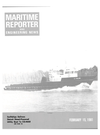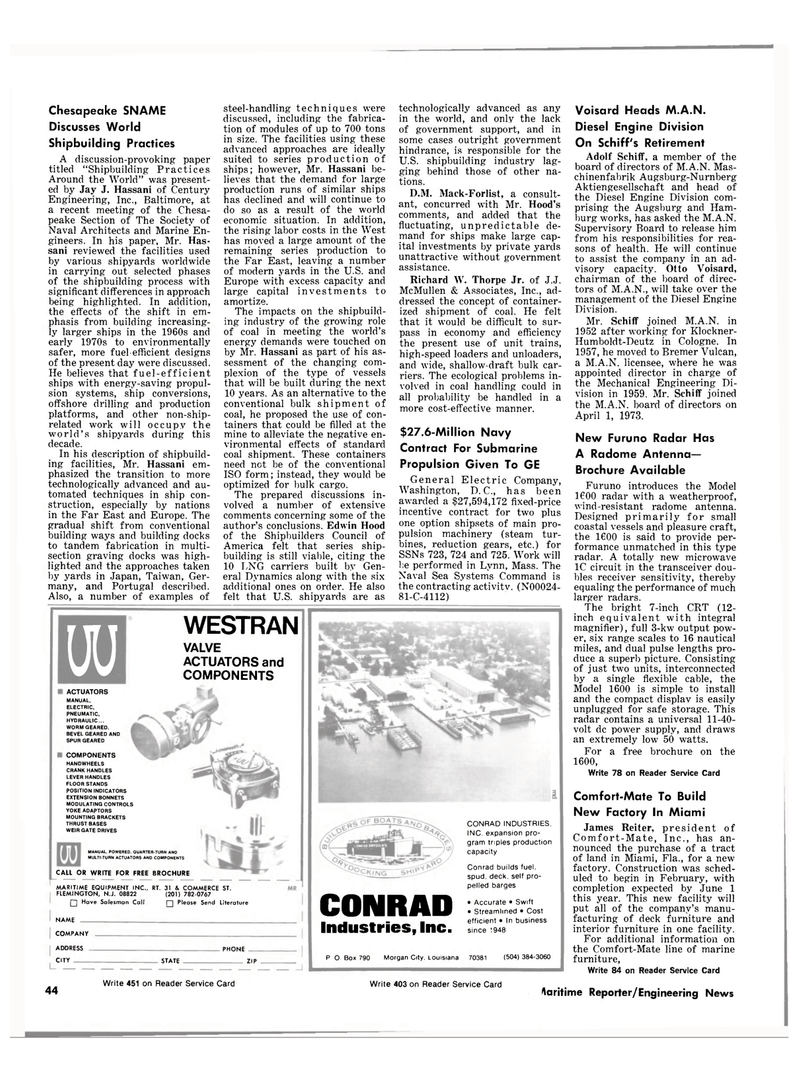
Page 42: of Maritime Reporter Magazine (February 15, 1981)
Read this page in Pdf, Flash or Html5 edition of February 15, 1981 Maritime Reporter Magazine
Chesapeake SNAME
Discusses World
Shipbuilding Practices
A discussion-provoking paper titled "Shipbuilding Practices
Around the World" was present- ed by Jay J. Hassani of Century
Engineering, Inc., Baltimore, at a recent meeting of the Chesa- peake Section of The Society of
Naval Architects and Marine En- gineers. In his paper, Mr. Has- sani reviewed the facilities used by various shipyards worldwide in carrying out selected phases of the shipbuilding process with significant differences in approach being highlighted. In addition, the effects of the shift in em- phasis from building increasing- ly larger ships in the 1960s and early 1970s to environmentally safer, more fuel-efficient designs of the present clay were discussed.
He believes that fuel-efficient ships with energy-saving propul- sion systems, ship conversions, offshore drilling and production platforms, and other non-ship- related work will occupy the world's shipyards during this decade.
In his description of shipbuild- ing facilities, Mr. Hassani em- phasized the transition to more technologically advanced and au- tomated techniques in ship con- struction, especially by nations in the Far East and Europe. The gradual shift from conventional building ways and building docks to tandem fabrication in multi- section graving docks was high- lighted and the approaches taken by yards in Japan, Taiwan, Ger- many, and Portugal described.
Also, a number of examples of steel-handling techniques were discussed, including the fabrica- tion of modules of up to 700 tons in size. The facilities using these advanced approaches are ideally suited to series production of ships; however, Mr. Hassani be- lieves that the demand for large production runs of similar ships has declined and will continue to do so as a result of the world economic situation. In addition, the rising labor costs in the West has moved a large amount of the remaining series production to the Far East, leaving a number of modern yards in the U.S. and
Europe with excess capacity and large capital investments to amortize.
The impacts on the shipbuild- ing industry of the growing role of coal in meeting the world's energy demands were touched on by Mr. Hassani as part of his as- sessment of the changing com- plexion of the type of vessels that will be built during the next 10 years. As an alternative to the conventional bulk shipment of coal, he proposed the use of con- tainers that could be filled at the mine to alleviate the negative en- vironmental effects of standard coal shipment. These containers need not be of the conventional
ISO form; instead, they would be optimized for bulk cargo.
The prepared discussions in- volved a number of extensive comments concerning some of the author's conclusions. Edwin Hood of the Shipbuilders Council of
America felt that series ship- building is still viable, citing the 10 LNG carriers built by Gen- eral Dynamics along with the six additional ones on order. He also felt that U.S. shipyards are as technologically advanced as any in the world, and only the lack of government support, and in some cases outright government hindrance, is responsible for the
U.S. shipbuilding industry lag- ging behind those of other na- tions.
D.M. Mack-Forlist, a consult- ant, concurred with Mr. Hood's comments, and added that the fluctuating, unpredictable de- mand for ships make large cap- ital investments by private yards unattractive without government assistance.
Richard W. Thorpe Jr. of J.J.
McMullen & Associates, Inc., ad- dressed the concept of container- ized shipment of coal. He felt that it would be difficult to sur- pass in economy and efficiency the present use of unit trains, high-speed loaders and unloaders, and wide, shallow-draft bulk car- riers. The ecological problems in- volved in coal handling could in all probability be handled in a more cost-effective manner. $27.6-Million Navy
Contract For Submarine
Propulsion Given To GE
General Electric Company,
Washington, D. C., has been awarded a $27,594,172 fixed-price incentive contract for two plus one option shipsets of main pro- pulsion machinery (steam tur- bines, reduction gears, etc.) for
SSNs 723, 724 and 725. Work will be performed in Lynn, Mass. The
Naval Sea Systems Command is the contracting activitv. (N00024- 81-C-4112)
Voisard Heads M.A.N.
Diesel Engine Division
On Schiff's Retirement
Adolf Sehiff, a member of the board of directors of M.A.N. Mas- chinenfabrik Augsburg-Nurnberg
Aktiengesellschaft and head of the Diesel Engine Division com- prising the Augsburg and Ham- burg works, has asked the M.A.N.
Supervisory Board to release him from his responsibilities for rea- sons of health. He will continue to assist the company in an ad- visory capacity. Otto Voisard, chairman of the board of direc- tors of M.A.N., will take over the management of the Diesel Engine
Division.
Mr. Schiff joined M.A.N, in 1952 after working for Klockner-
Humboldt-Deutz in Cologne. In 1957, he moved to Bremer Vulcan, a M.A.N, licensee, where he was appointed director in charge of the Mechanical Engineering- Di- vision in 1959. Mr. Schiff joined the M.A.N, board of directors on
April 1, 1973.
New Furuno Radar Has
A Radome Antenna-
Brochure Available
Furuno introduces the Model 1600 radar with a weatherproof, wind-resistant radome antenna.
Designed primarily for small coastal vessels and pleasure craft, the 1600 is said to provide per- formance unmatched in this type radar. A totally new microwave 1C circuit in the transceiver dou- bles receiver sensitivity, thereby equaling the performance of much larger radars.
The bright 7-inch CRT (12- inch equivalent with integral magnifier), full 3-kw output pow- er, six range scales to 16 nautical miles, and dual pulse lengths pro- duce a superb picture. Consisting of just two units, interconnected by a single flexible cable, the
Model 1600 is simple to install and the compact display is easily unplugged for safe storage. This radar contains a universal 11-40- volt dc power supply, and draws an extremely low 50 watts.
For a free brochure on the 1600,
Write 78 on Reader Service Card
Comfort-Mate To Build
New Factory In Miami
James Reiter, president of
Comfort-Mate, Inc., has an- nounced the purchase of a tract of land in Miami, Fla., for a new factory. Construction was sched- uled to begin in February, with completion expected by June 1 this year. This new facility will put all of the company's manu- facturing of deck furniture and interior furniture in one facility.
For additional information on the Comfort-Mate line of marine furniture,
Write 84 on Reader Service Card uu
ACTUATORS
MANUAL,
ELECTRIC,
PNEUMATIC,
HYDRAULIC...
WORM GEARED,
BEVEL GEARED AND
SPUR GEARED
COMPONENTS
HANDWHEELS
CRANK HANDLES
LEVER HANDLES
FLOOR STANDS
POSITION INDICATORS
EXTENSION BONNETS
MODULATING CONTROLS
YOKE ADAPTORS
MOUNTING BRACKETS
THRUST BASES
WEIR GATE DRIVES
WESTRAN
VALVE
ACTUATORS and
COMPONENTS
MANUAL, POWERED. QUARTER-TURN AND
MULTI-TURN ACTUATORS AND COMPONENTS
CALL OR WRITE FOR FREE BROCHURE
MARITIME EQUIPMENT INC., RT. 31 & COMMERCE ST.
FLEMINGTON, N.J. 08822 (201) 782-0767
Q Have Salesman Call Q Please Send Literature
NAME
COMPANY
ADDRESS _ . PHONE
CITY . STATE ZIP
CONRAD
Industries, Inc.
CONRAD INDUSTRIES.
INC. expansion pro- gram triples production capacity
Conrad builds fuel, spud, deck, self pro- pelled barges • Accurate • Swift • Streamlined • Cost efficient • In business since 1948
P O Box 790 Morgan City, Louisiana 70381 (504) 384-3060 44 Write 451 on Reader Service Card Write 403 on Reader Service Card Maritime Reporter/Engineering News

 41
41

 43
43
